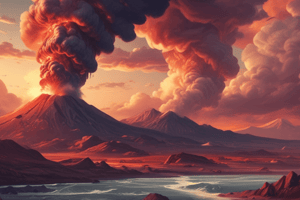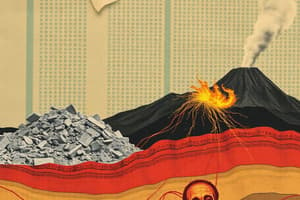Podcast
Questions and Answers
What is the main cause of ground swells or inflation near a volcano?
What is the main cause of ground swells or inflation near a volcano?
- Heavy rains
- Drying up of vegetation
- Localized landslides
- Magma intrusion (correct)
Which of the following is a characteristic of a sinkhole?
Which of the following is a characteristic of a sinkhole?
- Resulting from volcanic eruption
- Characterized by free-falling massive rocks
- Flow of debris and rock materials
- Formation due to water, erosion, and ground movement (correct)
What type of movement is associated with a slump?
What type of movement is associated with a slump?
- Rapid flow of debris and other rock materials
- Gradual movement of soil
- Characterized by flowing mass of mud along the flank of a volcano
- Downslope flow of soft and unconsolidated materials (correct)
Which sign is not typically associated with landslides?
Which sign is not typically associated with landslides?
What does creep refer to in geological terms?
What does creep refer to in geological terms?
Which phenomenon is characterized by noticeable variations in the chemical content of springs around a volcano?
Which phenomenon is characterized by noticeable variations in the chemical content of springs around a volcano?
What type of movement is rockfall associated with?
What type of movement is rockfall associated with?
What do noticeable bulges on the ground at foot slopes suggest?
What do noticeable bulges on the ground at foot slopes suggest?
What type of motion characterizes mudflow along the flank of a volcano?
What type of motion characterizes mudflow along the flank of a volcano?
What does the emergence of springs or seepages indicate about the ground?
What does the emergence of springs or seepages indicate about the ground?
Flashcards are hidden until you start studying
Study Notes
Earthquake Hazards and Preparedness
- The Philippines' formation is believed to be due to the collision of the Pacific and Eurasian plates, causing the crust to crumble.
- Fault lines are cracks on the Earth's surface along which smaller plates move or slip against each other.
- The focus is the place where the energy is released like an explosion.
- The epicenter is the point that is immediately above the focus.
- Earthquake is the weak or violent shaking of the earth's surface caused by the sudden movement of rock materials beneath it.
- Active fault lines are defined by PHIVOLCS as those moving within the last 10,000 years, exhibit historical seismicity through fault slips and displacement of rocks or soil.
- Magnitude is a measure of the total energy released at the earthquake's point of origin, which is below the Earth's surface.
- Seismograph is the instrument that measures magnitude.
- Richter magnitude scale is used to measure the strength of an earthquake.
- Intensity refers to the perceived strength of an earthquake, higher intensity felt in areas closer to the epicenter.
Earthquake Hazards
- Ground shaking
- Ground rupture (displacement of the ground due to violent shaking) • Vertical displacement • Horizontal displacement
- Liquefaction (increase in water pressure in saturated soil due to ground shaking)
- Ground subsidence (caused by activities like extraction of groundwater, mining, and earthquakes, can cause structures to tilt or collapse)
- Tsunamis (caused by earthquakes, large waves with heights of five meters or higher)
Earthquake Preparedness and Risk Reduction
Before
- Ensure your home has a fire extinguisher, first aid kit, radio, flashlight, and extra batteries.
- Learn first aid, gas, water, and electricity turns off, plan for family meetings, anchor heavy furniture, and learn earthquake plans.
During
- Stay calm during an earthquake by staying indoors, standing against walls, and away from windows and doors.
- Outdoors, stay in open spaces, away from power lines and buildings.
- Avoid using matches, candles, or flames.
- If in a car, stay inside until the earthquake stops.
After
- Check for injuries, provide first aid, and shut off water, gas, and electric lines if damaged.
- If gas smells, evacuate immediately and report to authorities.
- Turn on the radio, stay out of damaged buildings, wear sturdy shoes, and avoid chimneys.
- Stay away from beaches, follow emergency plans at school or work, and expect aftershocks.
Volcanic Eruption
- Volcanic eruption is a natural phenomenon in which molten rock, gas, and other materials are ejected from a volcano's vent or fissure onto the Earth's surface or into the atmosphere.
- A volcano is a vent on the Earth's surface that opens downward to a pool of molten rock, debris, and gases.
- Its formation involves the process of subduction.
Classification of Volcanoes
- Active volcano: currently erupting or showing signs of eruption, which should have occurred within the last 600 years.
- Potentially active volcano: one that has erupted and then entered a prolonged period of inactivity.
- Inactive volcano: has been largely unexplored for a long time, with no recorded eruptions in the past thousand years.
Volcanic Eruption Hazards
- Lava flow: a magma mass that flows down volcanic slopes, causing injuries and potentially burning structures and vegetation.
- Pyroclastic flow: hot, dry volcanic masses moving at over 60 km/h from a collapsed eruption column, while pyroclastic surges are turbulent currents of gases, debris, and water.
- Tephra falls: volcanic eruption-induced showers of fine to coarse-grained particles, causing pollution, health issues, poor visibility, and disruption of electricity and communication lines.
- Ballistic projectiles: rocks released by erupting volcanoes, can land within 2 kilometers of the vent but can travel up to 5 kilometers or more if the eruption is explosive.
- Volcanic gas: a key component of magma, can release harmful gases into the atmosphere, including water vapor, hydrogen sulfide, sulfur dioxide, carbon monoxide, hydrogen chloride, and hydrogen fluoride.
- Lahar: a mixture of volcanic debris and water, can be hot or cold, and can destroy structures and communities due to volcanic eruptions or heavy rainfall.
Landslides
- Landslides are geological phenomena involving the downward movement of soil, rocks, or debris along a slope, triggered by factors like gravity, heavy rainfall, earthquakes, and volcanic activity.
- Human activities like mining, deforestation, and construction of buildings negatively impact land surface, exposing and destabilizing the ground, which can lead to natural disasters and landslides.
Types of Landslide
- Creep: a flow or gradual movement of soil
- Slump: the downslope flow of soft and unconsolidated materials
- Rockfall: the free falling movement of massive rocks from a cliff or sleep slopes
- Debris flow: the rapid flow of debris and other rock materials
- Mudflow: characterized by a flowing mass of mud along the flank of a volcano
Signs of Eruption
- Increase in the frequency of volcanic quakes with rumbling sounds, occurrence of volcanic tremors
- Increased steaming activity; change in color of steam emission from white to gray due to entrained ash
- Crater glow due to presence of magma at or near the crater
- Ground swells (or inflation), ground tilt and ground fissuring due to magma intrusion
- Localized landslides, rock falls, and landslides from the summit area not attributable to heavy rains
- Noticeable increase in the extent of drying up of vegetation around the volcano's upper slopes
- Increase in the temperature of hot springs, wells, and crater lake near the volcano
- Noticeable variation in the chemical content of springs and crater lakes within the vicinity of the volcano
- Drying up of springs/wells around the volcano
Signs of Landslides
- Leaning door jambs and windows
- Cracks in concrete floors and windows
- Open spaces between walls and between stairs
- Cracks in roads that gradually increase in size
- Misalignment or snapping of buried pipes
- Bulges on the ground at foot slopes
- Emergence of springs or seepages
- Leaning trees, poles, and retaining walls
- Rumbling sound that may increasingly become louder
Studying That Suits You
Use AI to generate personalized quizzes and flashcards to suit your learning preferences.



